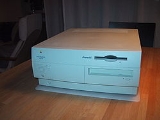
Power Macintosh 7500
Encyclopedia
The Power Macintosh 7500 was one of the first PCI
capable Macs manufactured by Apple Computer
. It was released alongside the Power Macintosh 7200
, and the Power Macintosh 8500
in October 1995. The 7500 had a PowerPC 601 processor rated at 100 MHz that was replaceable via a daughtercard. It also featured full composite video
and s-video
input capability, but no output, as the 7500 was designed to be a video conferencing system, not a multimedia editing machine—this was the 8500's task. The 7500 and 7200 featured a unique swing open chassis called "Outrigger
" that allowed for easy upgrades, as the entire motherboard was accessible to the user after the hinged drive sleds were opened.
There were two derivative models: the Power Macintosh 7600
, was identical to the 7500 except for the CPU
; the 7600 used a PowerPC 604 or 604e processor instead of the 601. The Power Macintosh 7300
, was identical to the 7600, but lacked the video inputs found in both the 7500 and 7600.
In the 7500 and its derivatives, the main bus runs at 45MHz or 50MHz (set by the CPU daughtercard), and the cpu at integer or half-integer multiples of this speed. The bus is temperamental, and can show sensitivity to different kinds of RAM or of L2 cache. Some cpu upgrades attempt to drive the main bus at a faster clock-rate, but success is not assured.
Peripheral Component Interconnect
Conventional PCI is a computer bus for attaching hardware devices in a computer...
capable Macs manufactured by Apple Computer
Apple Computer
Apple Inc. is an American multinational corporation that designs and markets consumer electronics, computer software, and personal computers. The company's best-known hardware products include the Macintosh line of computers, the iPod, the iPhone and the iPad...
. It was released alongside the Power Macintosh 7200
Power Macintosh 7200
The Power Macintosh 7200 is a personal computer that is a part of Apple Computer's Power Macintosh series of Macintosh computers. It was introduced in August 1995 as a successor to the Power Macintosh 7100, and was discontinued in favor of the Power Macintosh 7300 in February 1997...
, and the Power Macintosh 8500
Power Macintosh 8500
The Power Macintosh 8500 was a high-end Macintosh personal computer designed, manufactured and sold by Apple Computer from 1995 until 1997. Billed as a high-end graphics computer, the Power Macintosh 8500 was also the first Macintosh to ship with a replaceable daughtercard...
in October 1995. The 7500 had a PowerPC 601 processor rated at 100 MHz that was replaceable via a daughtercard. It also featured full composite video
Composite video
Composite video is the format of an analog television signal before it is combined with a sound signal and modulated onto an RF carrier. In contrast to component video it contains all required video information, including colors in a single line-level signal...
and s-video
S-Video
Separate Video, more commonly known as S-Video and Y/C, is often referred to by JVC as both an S-VHS connector and as Super Video. It is an analog video transmission scheme, in which video information is encoded on two channels: luma and chroma...
input capability, but no output, as the 7500 was designed to be a video conferencing system, not a multimedia editing machine—this was the 8500's task. The 7500 and 7200 featured a unique swing open chassis called "Outrigger
Outrigger Macintosh
The Outrigger is a style of Apple Macintosh desktop computercase designed for easy access. Outrigger cases were used on the Power Macintosh 7200, 7300, 7500, 7600 and Power Macintosh G3 Desktop computers from August 1995 to December 1998....
" that allowed for easy upgrades, as the entire motherboard was accessible to the user after the hinged drive sleds were opened.
There were two derivative models: the Power Macintosh 7600
Power Macintosh 7600
The Power Macintosh 7600 was a PowerPC 604 based desktop computer sold by Apple in three speeds between April 1996 and November 1997. The 7600 was essentially a Power Macintosh 7500 with a different CPU card, the change in model number occurring because of the move from the 7500's PPC601 to the...
, was identical to the 7500 except for the CPU
Central processing unit
The central processing unit is the portion of a computer system that carries out the instructions of a computer program, to perform the basic arithmetical, logical, and input/output operations of the system. The CPU plays a role somewhat analogous to the brain in the computer. The term has been in...
; the 7600 used a PowerPC 604 or 604e processor instead of the 601. The Power Macintosh 7300
Power Macintosh 7300
The Power Macintosh 7300 is a personal computer that is a part of Apple Computer's Power Macintosh series of Macintosh computers...
, was identical to the 7600, but lacked the video inputs found in both the 7500 and 7600.
In the 7500 and its derivatives, the main bus runs at 45MHz or 50MHz (set by the CPU daughtercard), and the cpu at integer or half-integer multiples of this speed. The bus is temperamental, and can show sensitivity to different kinds of RAM or of L2 cache. Some cpu upgrades attempt to drive the main bus at a faster clock-rate, but success is not assured.
See also
- List of Macintosh models grouped by CPU type
- List of products discontinued by Apple Computer

